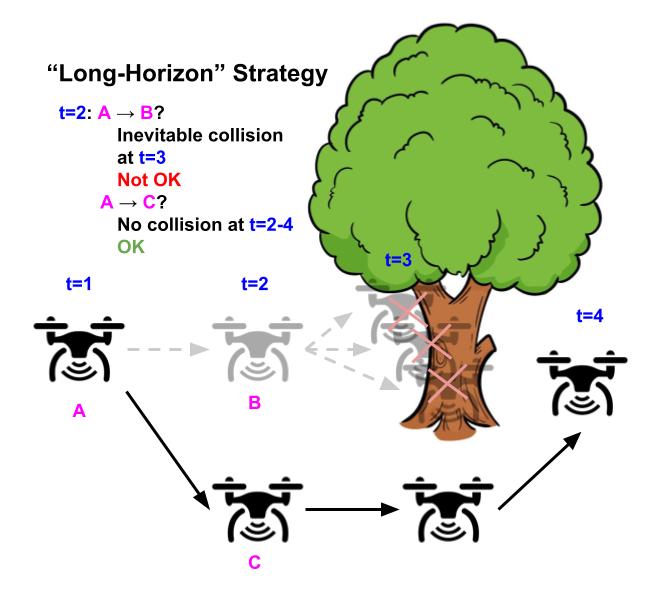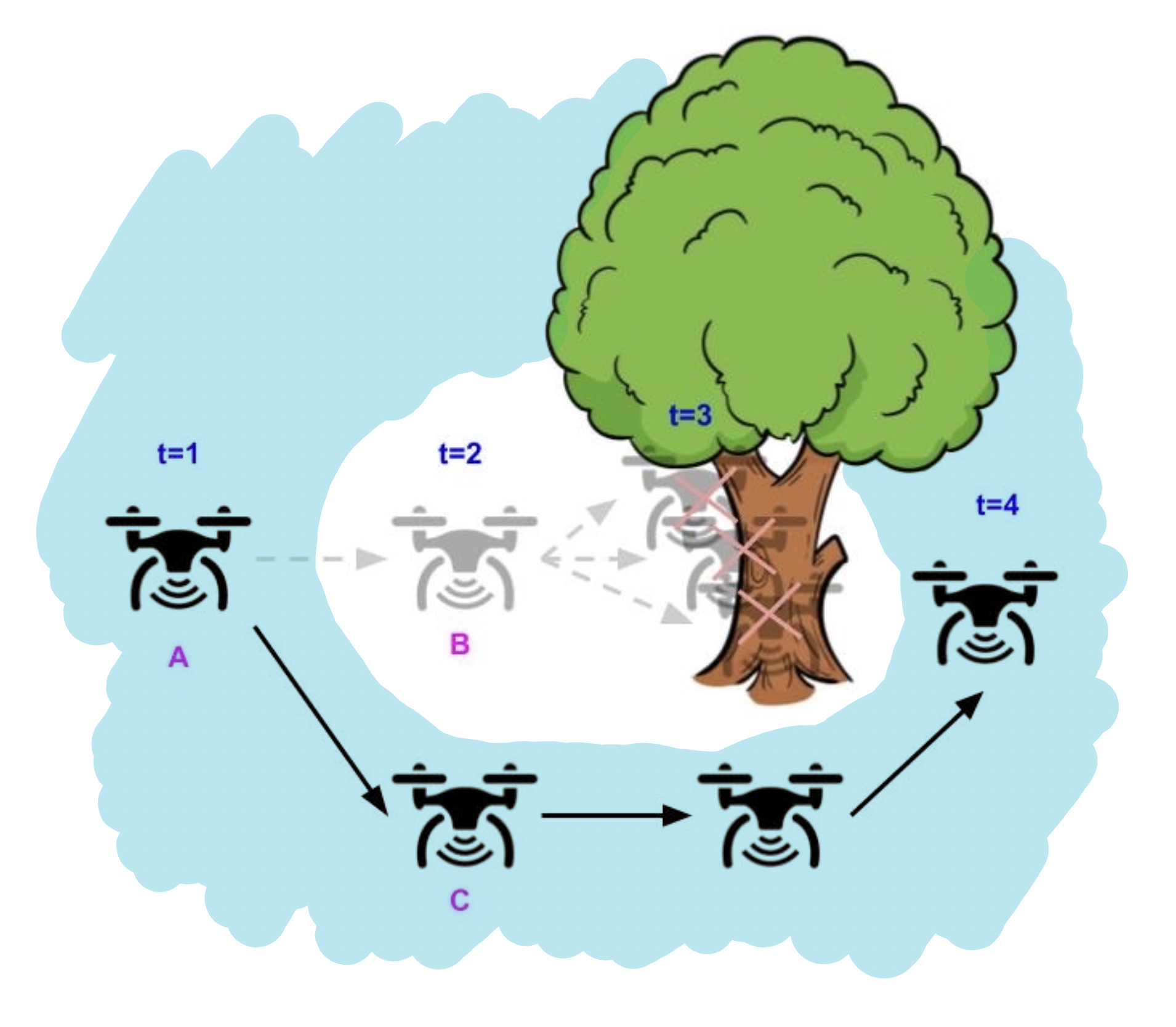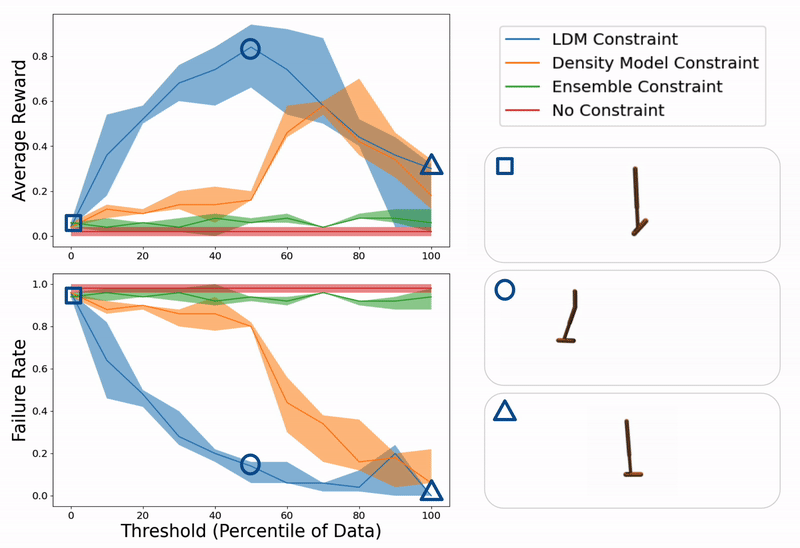
[ad_1]

To take care of the distribution shift experience by learning-based controllers, we search a mechanism for constraining the agent to areas of utmost information density all by its trajectory (left). Right correct proper right here, we present an methodology which achieves this goal by combining choices of density fashions (heart) and Lyapunov decisions (acceptable).
With a carry out to benefit from machine discovering out and reinforcement discovering out in controlling actual world strategies, we must always always design algorithms which not solely acquire good effectivity, nonetheless along with work along with the system in a protected and reliable methodology. Most prior work on safety-critical administration focuses on sustaining the safety of the bodily system, e.g. avoiding falling over for legged robots, or colliding into obstacles for autonomous vehicles. Nonetheless, for learning-based controllers, there may be additionally one fully totally different current of safety concern: on account of machine discovering out fashions are solely optimized to output related predictions on the educating information, they’re weak to outputting inaccurate predictions when evaluated on out-of-distribution inputs. Thus, if an agent visits a state or takes an movement which will be very completely absolutely fully totally different from these contained within the educating information, a learning-enabled controller might “exploit” the inaccuracies in its realized factor and output actions which can be suboptimal and even dangerous.
To cease these potential “exploitations” of model inaccuracies, we advocate a model new framework to motive referring to the safety of a learning-based controller with respect to its educating distribution. The central thought behind our work is to view the educating information distribution as a safety constraint, and to draw on devices from administration idea to take care of the distributional shift skilled by the agent all by way of closed-loop administration. Further significantly, we’ll care for how Lyapunov stability is perhaps unified with density estimation to supply Lyapunov density fashions, a model new kind of safety “barrier” carry out which can be utilized to synthesize controllers with ensures of defending the agent in areas of utmost information density. Forward of we introduce our new framework, we’ll first give a excessive diploma view of present strategies for guaranteeing bodily safety by barrier carry out.
In administration idea, a central matter of research is: given acknowledged system dynamics, $s_{t+1}=f(s_t, a_t)$, and acknowledged system constraints, $s in C$, how can we design a controller that is assured to take care of up the system all by way of the desired constraints? Right correct proper right here, $C$ denotes the set of states which can be deemed protected for the agent to go to. This draw again is troublesome on account of the specified constraints must be absolutely glad over the agent’s complete trajectory horizon ($s_t in C$ $forall 0leq t leq T$). If the controller makes use of a simple “greedy” strategy of avoiding constraint violations inside the following time step (not taking $a_t$ for which $f(s_t, a_t) notin C$), the system ought to nonetheless end up in an “irrecoverable” state, which itself is taken under consideration protected, nonetheless will inevitably end in an unsafe state in the long term regardless of the agent’s future actions. With a carry out to keep away from visiting these “irrecoverable” states, the controller ought to make use of a further “long-horizon” technique which entails predicting the agent’s complete future trajectory to keep away from safety violations at any diploma in the long term (keep away from $a_t$ for which all potential ${ a_{hat{t}} }_{hat{t}=t+1}^H$ end in some $bar{t}$ the place $s_{bar{t}} notin C$ and $t<bar{t} leq T$). Nonetheless, predicting the agent’s full trajectory at every step might be very computationally intensive, and usually infeasible to hold out on-line all by way of run-time.


Illustrative occasion of a drone whose goal is to fly as straight as potential whereas avoiding obstacles. Using the “greedy” strategy of avoiding safety violations (left), the drone flies straight on account of there’s no obstacle inside the following timestep, nonetheless inevitably crashes in the long term on account of it might most probably’t flip in time. In distinction, using the “long-horizon” technique (acceptable), the drone turns early and efficiently avoids the tree, by considering your full future horizon technique ahead for its trajectory.
Administration theorists sort out this draw back by designing “barrier” decisions, $v(s)$, to constrain the controller at each step (solely allow $a_t$ which fulfill $v(f(s_t, a_t)) leq 0$). With a carry out to verify the agent stays protected all by its complete trajectory, the constraint induced by barrier decisions ($v(f(s_t, a_t))leq 0$) prevents the agent from visiting every unsafe states and irrecoverable states which inevitably end in unsafe states in the long term. This methodology primarily amortizes the computation of trying into the long term for inevitable failures when designing the safety barrier carry out, which solely should be achieved as shortly as and is perhaps computed offline. This vogue, at runtime, the security solely must make use of the greedy constraint satisfaction technique on the barrier carry out $v(s)$ as a strategy to assure safety for all future timesteps.

The blue home denotes the of states allowed by the barrier carry out constraint, $ v(s) leq 0$. Using a “long-horizon” barrier carry out, the drone solely must greedily make certain that the barrier carry out constraint $v(s) leq 0$ is completely glad for the next state, as a strategy to keep away from safety violations for all future timesteps.
Right correct proper right here, we used the notion of a “barrier” carry out as an umbrella time interval to clarify quite a lot of completely differing kinds of decisions whose functionalities are to constrain the controller as a strategy to make long-horizon ensures. Some particular examples embody administration Lyapunov decisions for guaranteeing stability, administration barrier decisions for guaranteeing frequent safety constraints, and the price carry out in Hamilton-Jacobi reachability for guaranteeing frequent safety constraints beneath exterior disturbances. Further right now, there has moreover been some work on discovering out barrier decisions, for settings the place the system is unknown or the place barrier decisions are troublesome to design. Nonetheless, prior works in every typical and learning-based barrier decisions are primarily centered on making ensures of bodily safety. All by the following half, we’ll care for how we’re in a position to lengthen these ideas to take care of the distribution shift skilled by the agent when using a learning-based controller.
To cease model exploitation attributable to distribution shift, many learning-based administration algorithms constrain or regularize the controller to cease the agent from taking low-likelihood actions or visiting low probability states, as an illustration in offline RL, model-based RL, and imitation discovering out. Nonetheless, most of these methods solely constrain the controller with a single-step estimate of the information distribution, akin to the “greedy” strategy of defending an autonomous drone protected by stopping actions which causes it to crash inside the following timestep. As we seen contained within the illustrative figures above, this method merely is simply not passable to make certain that the drone is solely not going to crash (or go out-of-distribution) in a single fully totally different future timestep.
How can we design a controller for which the agent is assured to stay in-distribution for its complete trajectory? Recall that barrier decisions could also be utilized to make sure constraint satisfaction for all future timesteps, which is strictly the kind of guarantee we hope to make practically concerning the information distribution. Based mostly fully on this commentary, we advocate a model new kind of barrier carry out: the Lyapunov density model (LDM), which merges the dynamics-aware aspect of a Lyapunov carry out with the data-aware aspect of a density model (it is the reality is a generalization of every kinds of carry out). Analogous to how Lyapunov decisions retains the system from turning into bodily unsafe, our Lyapunov density model retains the system from going out-of-distribution.
An LDM ($G(s, a)$) maps state and movement pairs to unfavorable log densities, the place the values of $G(s, a)$ signify the right information density the agent is able to shield above all by its trajectory. It might be intuitively considered a “dynamics-aware, long-horizon” transformation on a single-step density model ($E(s, a)$), the place $E(s, a)$ approximates the unfavorable log probability of the information distribution. Since a single-step density model constraint ($E(s, a) leq -log(c)$ the place $c$ is a cutoff density) would possibly nonetheless allow the agent to go to “irrecoverable” states which inevitably causes the agent to go out-of-distribution, the LDM transformation will enhance the price of those “irrecoverable” states until they develop to be “recoverable” with respect to their updated worth. On account of this, the LDM constraint ($G(s, a) leq -log(c)$) restricts the agent to a smaller set of states and actions which excludes the “irrecoverable” states, thereby making certain the agent is able to maintain in extreme data-density areas all by its complete trajectory.

Occasion of information distributions (heart) and their associated LDMs (acceptable) for a 2D linear system (left). LDMs is perhaps thought-about “dynamics-aware, long-horizon” transformations on density fashions.
How exactly does this “dynamics-aware, long-horizon” transformation work? Given an info distribution $P(s, a)$ and dynamical system $s_{t+1} = f(s_t, a_t)$, we define the following on account of the LDM operator: $mathcal{T}G(s, a) = max{-log P(s, a), min_{a’} G(f(s, a), a’)}$. Suppose we initialize $G(s, a)$ to be $-log P(s, a)$. Beneath one iteration of the LDM operator, the price of a state movement pair, $G(s, a)$, can each maintain at $-log P(s, a)$ or improve in worth, counting on whether or not or not or not or not the price on the superb state movement pair inside the following timestep, $min_{a’} G(f(s, a), a’)$, is larger than $-log P(s, a)$. Intuitively, if the price on the superb subsequent state movement pair is larger than the current $G(s, a)$ worth, which signifies that the agent is unable to remain on the current density diploma irrespective of its future actions, making the current state “irrecoverable” with respect to the current density diploma. By rising the current the price of $G(s, a)$, we’re “correcting” the LDM such that its constraints would not embody “irrecoverable” states. Right correct proper right here, one LDM operator substitute captures the impact of trying into the long term for one timestep. If we repeatedly apply the LDM operator on $G(s, a)$ until convergence, the final word phrase LDM is perhaps free of “irrecoverable” states contained within the agent’s complete future trajectory.
To benefit from an LDM in administration, we’re in a position to put collectively an LDM and learning-based controller on the equal educating dataset and constrain the controller’s movement outputs with an LDM constraint ($G(s, a)) leq -log(c)$). On account of the LDM constraint prevents every states with low density and “irrecoverable” states, the learning-based controller shall be succesful to keep away from out-of-distribution inputs all by the agent’s complete trajectory. Furthermore, by deciding on the cutoff density of the LDM constraint, $c$, the consumer is able to administration the tradeoff between defending throughout the course of model error vs. flexibility for performing the desired practice.

Occasion evaluation of ours and baseline methods on a hopper administration practice for fairly a couple of values of constraint thresholds (x- axis). On the turning into, we current occasion trajectories from when the sting is just too low (hopper falling over attributable to excessive model exploitation), good (hopper efficiently hopping in path of aim location), or too extreme (hopper standing nonetheless attributable to over conservatism).
Thus far, we’ve got now solely talked regarding the properties of a “good” LDM, which is perhaps found if we had oracle entry to the information distribution and dynamical system. In modify to, though, we approximate the LDM using solely information samples from the system. This causes a problem to return up: although the place of the LDM is to cease distribution shift, the LDM itself might endure from the unfavorable outcomes of distribution shift, which degrades its effectiveness for stopping distribution shift. To know the diploma to which the degradation happens, we analyze this draw again from every a theoretical and empirical perspective. Theoretically, we current even when there are errors contained within the LDM discovering out course of, an LDM constrained controller stays to have the flexibility to guard ensures of defending the agent in-distribution. Albeit, this guarantee is a bit weaker than the distinctive guarantee provided by a super LDM, the place the amount of degradation relies upon upon upon the size of the errors contained within the discovering out course of. Empirically, we approximate the LDM using deep neural networks, and current that using a realized LDM to constrain the learning-based controller nonetheless provides effectivity enhancements in distinction with using single-step density fashions on quite a lot of domains.

Evaluation of our technique (LDM) in distinction with constraining a learning-based controller with a density model, the variance over an ensemble of fashions, and no constraint within the least on quite a lot of domains along with hopper, lunar lander, and glucose administration.
At current, positively one amongst many largest challenges in deploying learning-based controllers on actual world strategies is their potential brittleness to out-of-distribution inputs, and lack of ensures on effectivity. Conveniently, there exists a vast physique of labor in administration idea centered on making ensures about how strategies evolve. Nonetheless, these works usually take care of making ensures with respect to bodily safety requirements, and assume entry to an relevant dynamics model of the system along with bodily safety constraints. The central thought behind our work is to as an alternative view the educating information distribution as a safety constraint. This permits us to benefit from these ideas in controls in our design of learning-based administration algorithms, thereby inheriting every the scalability of machine discovering out and the rigorous ensures of administration idea.
This submit depends upon the paper “Lyapunov Density Fashions: Constraining Distribution Shift in Discovering out-Based mostly Administration”, launched at ICML 2022. You
uncover extra particulars in our paper and on our website. We thank Sergey Levine, Claire Tomlin, Dibya Ghosh, Jason Choi, Colin Li, and Homer Walke for his or her priceless ideas on this weblog submit.
[ad_2]